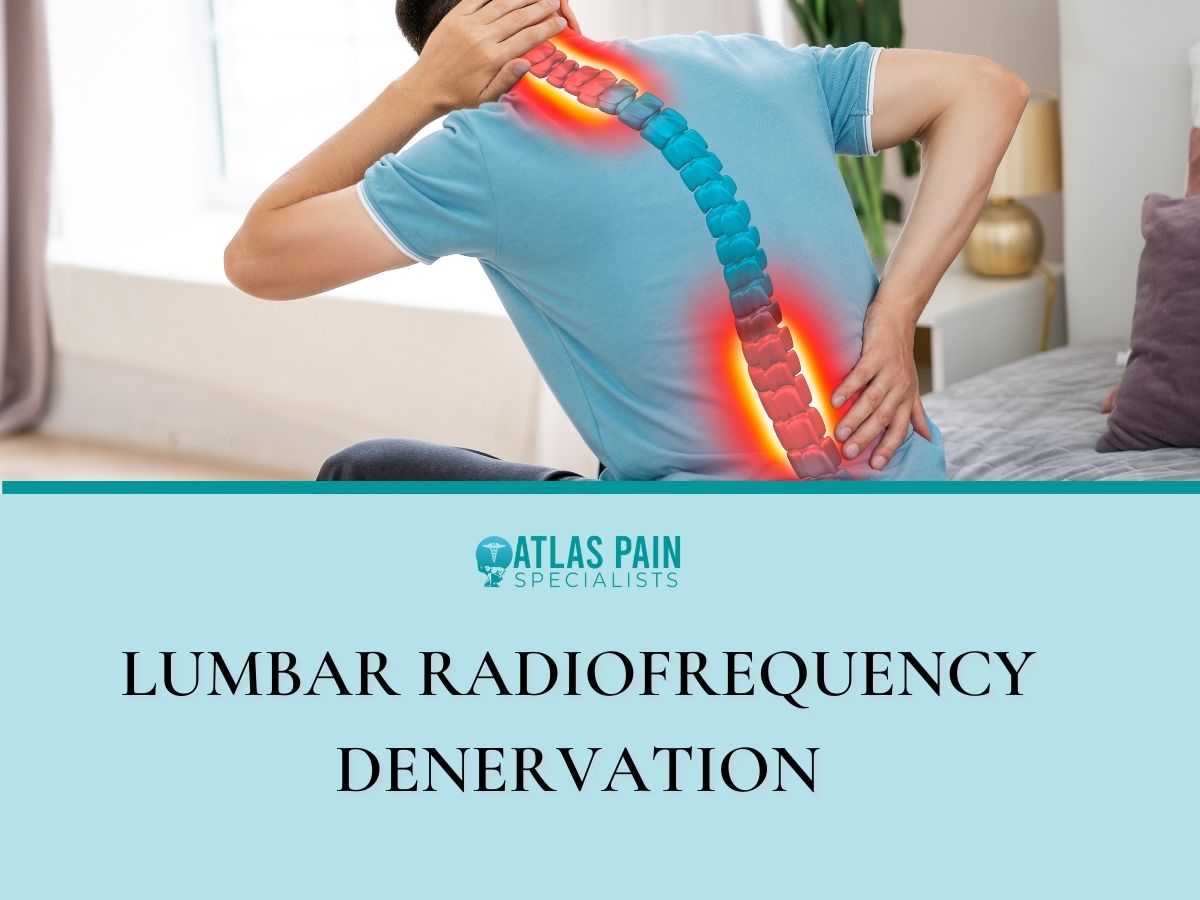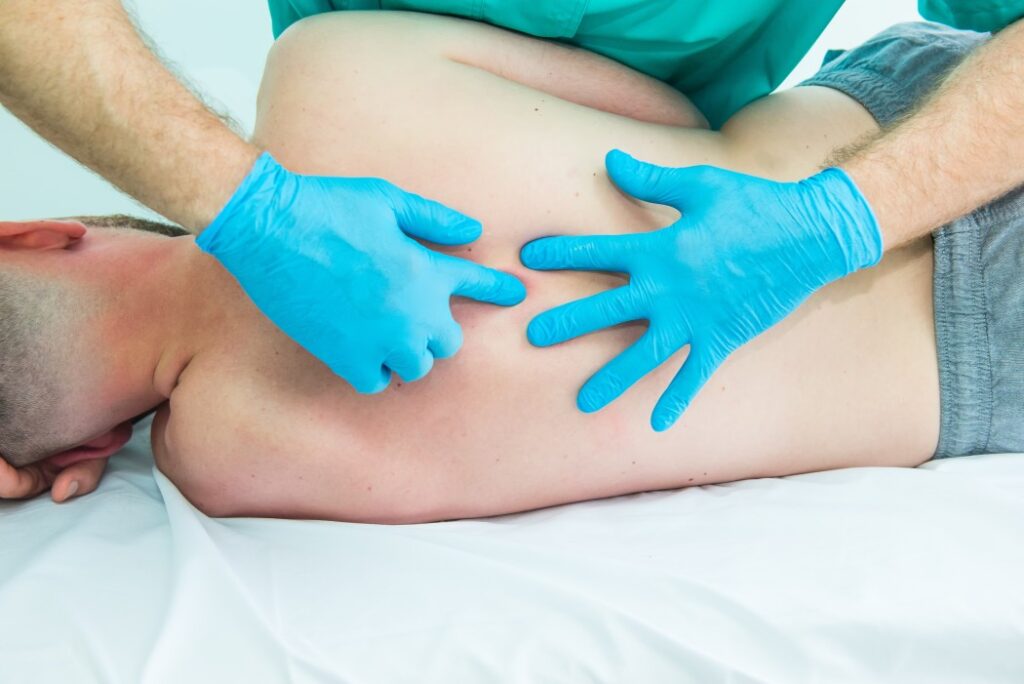

Lumbar Radiofrequency Denervation
What is Lumbar Radiofrequency Denervation?
Lumbar radiofrequency denervation (RFD) is a procedure used to treat low back, buttock, hip, and groin pain, among other symptoms. Lumbar facet thermal coagulation, rhizotomy, and radiofrequency ablation are terms used to describe this procedure.
What Conditions Can Lumbar Radiofrequency Denervation Treat?
Several conditions can be treated using radiofrequency ablation:
Low-Back Pain
Low-back discomfort is a common condition that affects a large number of people- a recent study has shown that more than 80% of the population will experience back pain.
The sacroiliac joint, lumbar facet joints(link), and intervertebral disc may all be responsible for this sort of pain. In the case of persistent back pain, radiofrequency nerve ablation is a highly effective therapeutic option to consider.
Chronic Pain
Chronic pain is defined as pain that does not respond to pain medication, lasting three months or more after being treated. Chronic pain affects hundreds of thousands of individuals.
This type of discomfort negatively impacts your sleep, emotions, physical and social health, as well as your ability to function. Patients are referred to RFA when a physician cannot establish the source of their discomfort.
Arthritis
Arthritis is both uncomfortable and embarrassing for the person experiencing it.
Arthritis is a general phrase used to refer to many ailments that can affect the joints, such as your knees, fingers, and in some cases, hips. Some factors, including age, bacterial infections, trauma, and heredity, contribute to the development of arthritis.
Radiofrequency ablation may be beneficial for people with arthritis.
How Quickly Does Lumbar Radiofrequency Denervation Reduce Pain?
Pain relief can take up to three weeks to be noticeable.
The critical thing to remember is that the nerve may regenerate, which means that your pain may return in the future.
How Effective is Lumbar Radiofrequency Denervation?
Numerous studies have found that radiofrequency nerve ablation is 70% to 80% effective in people who have previously had successful nerve block procedures.
Patients will experience pain relief after ten days of starting therapy, and the relief will last for nine months to two years on average after that.
Is Lumbar Radiofrequency Denervation an Uncomfortable Procedure?
Most side effects are not deemed severe and disappear on their own within a short period.
Radiofrequency denervation may or may not provide pain relief, and the technique may or may not worsen your pain at the time of the operation.
What Are the Risks of Lumbar Radiofrequency Denervation?

The risks that may occur after treatment are relatively rare and resolve independently after a short period. Alongside being aware of the risks, preparing for them is far more important. One or more of the following may apply to you:
- One week after the surgery, the injection site may be slightly bruised or uncomfortable, and you may experience pain, but it should pass quickly.
- After the operation, there may be some bruising or pain around the operation site.
- You may get prickly, uncomfortable skin on your back (similar to a sunburn), which can last for several months at a time in some cases.
- It is not unusual after a lower back injection to have numbness or weakness in the legs, which usually subsides within minutes or hours after starting therapy.
There are just a few major health concerns associated with lumbar radiofrequency denervation.
- You must contact your doctor immediately if the area where the injection was administered turns warm or red and you feel uneasy or unwell after receiving the injection.
- Additionally, there is a potential that you will injure a nerve in your spine, but this is quite rare. Before treating the nerve, your doctor will use X-rays and clinical knowledge to check that the needle is put exactly into the nerve and functioning properly.
- You should call the institution where you had the operation if you get a headache or fever after coming home and if you continue to have numbness or weakness.
Lumbar Radiofrequency Denervation Pre-and Post-Injection Guidelines
Before the use of radiofrequency neurotomy
If you are on blood-thinning drugs or anticoagulants tell your doctor. If this is the case, you may need to discontinue taking them temporarily. Take the steps given below:
- Make plans for a ride home.
- Take any necessary prescriptions as early in the day as possible, with just water or other clear beverages as a companion. Do not take prescription drugs for at least two hours after surgery.
- Do not smoke or use any tobacco products on the day of your treatment.
During radiofrequency neurotomy
Typical radiofrequency treatment is a simple procedure, and patients are allowed to go home upon completion.
- An intravenous line will be inserted into your arm or hand to provide medication to make you comfortable while undergoing the treatment process.
- You will be given numbing medication to apply to your skin before installing the radiofrequency needles.
- Later, the doctor will use a fluoroscope to precisely insert the needles to nerve tissue that has been identified.
After radiofrequency neurotomy
Your belongings will be taken to a private room where you may relax until you are ready to return home.
The area where the needles were inserted may feel a little sore, but this should lessen within a day or two.
Complete pain relief is predicted after two to three weeks of the treatment, as it may take time for the ablated nerves to die and cease transmitting pain.
When you get back to your house
If you notice any discomfort at the injection sites, administer an ice pack to relieve the pain.
You should start your recovery process by applying a cold pack to the sore areas three to four times daily for around 20 minutes.
Avoid heating the injection areas with a heating pad.
For two days, refrain from taking a bath. Once 24 hours have passed since your treatment, you can take a warm shower.
What Does Lumbar Radiofrequency Denervation Entail?

RFA can be performed with or without sedation to a minor degree. Although patients are kept awake and vigilant throughout nerve stimulation and lesioning,
If an anesthetic is used, they are typically awake and alert enough to describe their symptoms. The RFA procedure consists of the following steps:
- Patients are placed on a treatment table with their stomachs flat. An intravenous (IV) line is put up if sedation is necessary to administer calming medication during the treatment.
- The skin around the treatment area (neck, mid-back, or lower back) is adequately cleaned to prevent infection.
- The physician uses a numbing chemical, anesthesia, to numb a tiny area of skin near the RFA injection site before performing the procedure.
- An RFA needle is directed onto the medial or lateral branch nerves using live x-ray guidance, professional known as fluoroscopy.
- Pain is transmitted from the facet joint to the spinal cord, located at the base of the spine via the medial branch nerves.
- Pain signals are transmitted from the spine to the brain via facet joints linked by two medial branch nerves.
- The brain receives pain signals from the lateral branch nerves of the sacroiliac joints in the pelvis, located between the sacrum and the ilium. The sacrum and ilium are where they are located.
- Once the needle tip has been properly positioned, an active electrode is inserted into the needle. A small quantity of electrical current is carefully transferred near the target nerve while keeping a safe distance from neighboring nerves.
This current may temporarily imitate the patient's typical painful sensations for a brief period.
- After establishing the presence of the target nerve, a heat lesion is produced on the nerve using the ablation method selected earlier (conventional, pulsed, or water-cooled radiofrequency).
- For each remaining nerve, the proceedure is repeated.
- Between 30 and 90 minutes are typically required to finish the whole treatment process.
- It is recommended that the patient be driven home by another person immediately following treatment.
Frequently Asked Questions:
How Long Is Recovery From Lumbar Radiofrequency Denervation?
In most cases, treatment significantly reduces lumbar back pain; however, a small percentage of patients may experience discomfort for the first 1-2 weeks after treatment.
Even though total healing takes around three weeks, normal activity can be resumed within that time frame if no discomfort is experienced.
If I'm Still in Pain- How Long After Can I Rebook Another Lumbar Radiofrequency Denervation?
If the patient only receives a minor amount of alleviation after receiving radiofrequency ablation treatment, the procedure can be repeated two or three weeks later with later.
How Long Does Lumbar Radiofrequency Ablation Last in Terms of Years?
Pain relief might last for anything from nine months to two years or longer in some cases.
Radiofrequency ablation has a success rate of 70-80 percent in those who have effectively blocked their nerves with medication.
If it's deemed necessary, or if the treatment is unsuccessful, the process may need to be repeated.
What Happens If the Lumbar Radiofrequency Ablation Doesn't Work?
In certain situations, the nerves targeted during the surgery may regrow, resulting in the recurrence of your discomfort.
If the radiofrequency ablation momentarily reduced your discomfort, but the pain reappeared after a few months, it may be advantageous to have the operation done again in the future.
Would You Like to Learn More About Lumbar Radiofrequency Denervation?
We urge you to contact Atlas Pain Specialists if you reside in the Phoenix region and have questions about Lumbar Radiofrequency Denervation.
We will carefully review your injuries and medical records to identify the best course of action for relieving your pain and regaining your mobility. Make a same-day appointment now!
About Dr. Sean Ormond



